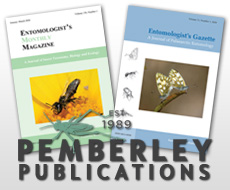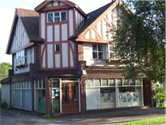Entomologist's Monthly Magazine - Vol. 161, No. 2, 2025
Published: 4/25/2025
Article Details for this issue
EDITORIAL
By: ANDREW WAKEHAM-DAWSON & IAN JOHNSON
Page: 73
Type: Editorial
Junonia orithya here Lang (Lepidoptera: Nymphalidae): a first documented observation in western Syria?
By: EDDIE JOHN, ZIAD ALEISSA, MUDAR SALIMEH & ONAT BASBAY
Page: 74–82
Type: Paper
Synopsis:
Species of the genus Junonia are widely regarded as vigorous migrants, with Junonia orithya here Lang no exception. From probable semi-permanent populations in the southern Negev (established populations in the Hejaz, Saudi Arabia being the likely origin), migrants move north. Here, we report on the first known appearance of J. orithya in northwestern Syria, close to the borders with the Mediterranean Turkish provinces of Hatay and Osmaniye in which the species has also been recorded. To the east, in central and eastern areas of Syria, we highlight the importance of the Euphrates River, its tributary the Khabur, and the Tigris River as conduits for migrant butterflies (including J. orithya) moving northwards through Iraq. Migrant J. orithya have yet to achieve permanent populations in the countries of the Levant or in southeastern Turkey (Türkiye). We also discuss Junonia hierta, placing on record the presence in the Museum für Naturkunde, Berlin of specimens of J. hierta cebrene Trimen collected in Beirut by Cremona in 1896.
Revival of the Afrotropical genus Tenuicosta Stein from synonymy and description of T. hairya sp. n. (Diptera: Muscidae) from Madagascar
By: EBERHARD ZIELKE
Page: 83–99
Type: Paper
Synopsis:
Close examination of the muscid genus Tenuicosta Stein confirms it as distinct from Coenosia Meigen and it is here revived as a separate genus. Tenuicosta (status revivisco) is marked by combination of only two postsutural dorsocentral setae, costa only reaching apex of vein R4 + 5, absence of median posterior seta of mid tibia and presence of a strong and long posterior seta close to the base of mid tibia. These features occur in the genus Coenosia either very rarely or not at all, and certainly not in such a combination. In addition, Tenuicosta hairya sp. n. is described as the second species of Tenuicosta.
A new genus of lined flat bark beetles in Early Eocene amber from northern France (Coleoptera: Laemophloeidae)
By: MICHAEL S. ENGEL & ANDRÉ NEL
Page: 100–106
Type: Paper
Synopsis:
A new genus and species of fossil lined flat bark beetles (Cucujoidea: Laemophloeidae) is described and figured from the lowermost Eocene (Ypresian) amber of Oise, northern France. Oisephloeus resinatus gen. & sp. n. is quite similar to the genus Lathropus Erichson but may be distinguishable by the tarsal formula and the pro- and mesocoxal cavities. Further determination awaits extensive phylogenetic analysis of the family and additional fossil data. While relationships may be obscure, Oisephloeus gen. n. nonetheless provides an important calibration point for understanding the history of Laemophloeidae.
Portrait of an entomologist – Eustace Frederic Wallis (1869–1946)
By: IAN D. HODKINSON
Page: 107–113
Type: Paper
Synopsis:
An illustrated biographical sketch of the entomologist Eustace Wallis whose oil portrait image was captured, net in hand, by his brother Hugh Wallis, a noted Arts and Crafts painter is presented. Eustace, a solicitor by training, specialised initially on the Lepidoptera of Northamptonshire before shifting his attention to Diptera and Hymenoptera. His notebooks are lavishly illustrated with water-colour images of insects, demonstrating his own high skills as an artist. He was also an inventor with several patents to his name, a lecturer, and a would-be Labour politician.
Diphyus latebricola (Wesmael) (Hymenoptera: Ichneumonidae: Ichneumoninae) new to Britain
By: JASWINDER S. BOPARAI & OLIVER WADSWORTH
Page: 114–124
Type: Paper
Synopsis:
Based on a single female specimen collected in the Wyre Forest, Worcestershire, the Darwin wasp Diphyus latebricola (Wesmael) is recorded in Britain for the first time. Photos of the specimen are presented, with notes on identification and a re-description of the species.
The Curtis collection of Idiocerini, and identity of Idiocerus maculicollis Curtis (Auchenorrhyncha: Cicadellidae) resolved
By: STUART FOSTER
Page: 125–131
Type: Paper
Synopsis:
John Curtis died in 1862 after which his then wife sold his insect collections to the National Museum of Victoria. The collections were placed in zinc-lined cabinets and sailed to Australia where they remain. In December 2019, SF was able to examine the specimens of Auchenorrhyncha, Cicadellidae, Eurymelinae, Idiocerini within the Curtis collection enabling confirmation of their identification. The identity of Idiocerus maculicollis Curtis is established for the first time.
A new species of Haulepta Disney (Diptera: Phoridae) from Mallorca
By: MARK D. WELCH & BRIAN V. BROWN
Page: 132–141
Type: Paper
Synopsis:
Haulepta riddifordi sp. n. (Diptera: Phoridae) is described from Port de Pollensa in Mallorca. It is evaluated against the genera Pseudacteon Coquillett, Apocephalus Coquillett, Veruanus Schmitz, Lepta Schmitz and the only other described member of the genus Haulepta, H. sheasbyi Disney. The female oviscape is weakly sclerotised and is similar to that of Microselia southwoodi Disney; it lacks the well-developed scythe-like structure that is characteristic of, for example, Pseudacteon. There is a possible association with ants of the genus Tapinoma Fabricius (Formicidae), which were abundant at the trapping site.
Palaearctic Anomaloninae (Hymenoptera: Ichneumonidae) in the National Museums of Scotland, with description of a new species, resurrection of another, and keys to the revised British fauna
By: MARK R. SHAW, HEINZ SCHNEE & ASHLEIGH L. WHIFFIN
Page: 142–182
Type: Paper
Synopsis:
Over 1200 specimens of 58 species of Palaearctic Anomaloninae in the National Museums of Scotland are reviewed, and many host records of British and European species are given, often with comments on the host repertoire and phenology of species. The British fauna is revised (involving also other collections), with 12 additions including description of Camposcopus ruficoxis Schnee & Shaw sp. n. and resurrection of Agrypon cognatum Förster,1860 stat. rev. Attention is drawn to British records from a previous publication (Gauld & Mitchell 1977) that are believed to be erroneous. Illustrated keys for the identification of all species recorded from Britain (including questionable records) and a few further species likely to occur are provided.
BOOK REVIEW ‘CROP POLLINATION BY BEES’ [Vols 1 & 2] by K.S. Delaplane
By: MICHAEL S. ENGEL
Page: 183–184
Type: Book Review



